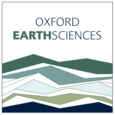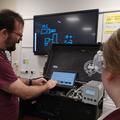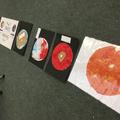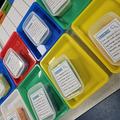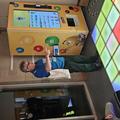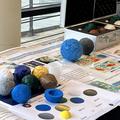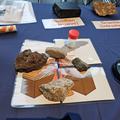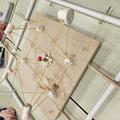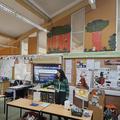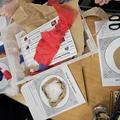Schools
We offer a variety of exciting and immersive workshops that complement the primary and secondary curriculum, both in schools and in the Department.
Our in-school workshops are free for state schools in Oxfordshire, and we typically only require a parking space on the day. Prices for other schools are available on request. To book a workshop please contact our Outreach Team at outreach@earth.ox.ac.uk.
If you are visiting Oxford, you can request an Earth Sciences taster session as part of your schedule. Please see the relevant tab below for more information.
Bookings are now closed for the 2024/5 academic year. To request a workshop for 2025/26, please email us from 1st July.
The Department of Earth Sciences is proud to take part in a number of science fairs and community events across the year, including the Oxford Brookes Science Bazaar (February) and the MPLS Earth Day Event (April). If you would like us to attend your event, please contact the Outreach Team.
Discover Our Workshops
Rocks and Volcanoes
This engaging, practical workshop allows the students to get experience handling igneous rocks and discuss volcanic processes. Students describe rock samples, think about where in a volcano they formed and have the opportunity to experience wearing a volcanologist suit. They then take part in a series of whole-class experiments which investigate volcanic eruptions.
Suitable for: Year 3 and Year 4
National curriculum links: Rocks (Science), Volcanoes and Earthquakes (Geography)
Duration: 75 minutes
Maximum number of students: 30
Space requirements: Classroom with a projector, a sink and access to an outdoor space, table for setting up demonstrations, smaller tables for students to work at
Planetary Interiors
This creative workshop involves learning about planetary compositions and how this relates to the distance between a planet and its nearest star. Students discuss the ‘snow line’, the boundary between rocky planets and gas giants. They then design their own planet with different materials. Together, the class then create their own planetary system. Designed by Hannah Sanderson.
Suitable for: Year 5 and Year 6
National curriculum links: Materials (Science), Earth and Space (Science), Rocks and States of Matter (Science)
Duration: 60 minutes
Maximum number of students: 30
Space requirements: Classroom with a projector and tables for students to work at
Volatile Volcanoes
This experiment-based workshop gives students the chance to discover the science of volcanic eruptions and how to predict them. They learn about what volcanic eruptions are, the role of gases, and think about how different types of magma affect explosivity. Students then become a team of volcanologists, whose role it is to observe and predict the behaviours of a volcano and successfully evacuate their island.
Suitable for: Year 5 and Year 6
National curriculum links: Rocks (Science), Volcanoes and Earthquakes (Geography)
Duration: 65 minutes
Maximum number of students: 30
Space requirements: Classroom with a projector, a sink and access to an outdoor space, table for setting up demonstrations, smaller tables for students to work at
Shaking Quakes
This practical workshop introduces students to the science behind earthquakes and how they are detected, before giving them the opportunity to build and test their own earthquake-proof structures. Students are challenged to build the tallest structure they can before using our shaker tables to see if they can withstand an earthquake. Designed by Rebecca Colquhoun.
Suitable for: Year 5 and Year 6
National curriculum links: Volcanoes and Earthquakes (Geography)
Duration: 60 minutes
Maximum number of students: 30
Space requirements: Classroom with a projector and large tables
Fantastic Fossils
This hands-on workshop introduces students to fossils and fossilisation, with the opportunity to handle a collection of fossils from different environments and time periods. Students then investigate sets of trilobite fossils - an ancient arthropod - and understand the differences in their features and what this tells us about their species, and the environments they were best adapted to. Designed by Stephanie Lechki.
Suitable for: Year 5 and Year 6
National curriculum links: Evolution and Inheritance (Science)
Duration: 60 minutes
Maximum number of students: 30
Space requirements: Classroom with a projector and tables for students to work at
Phenomenal Planets
This interactive workshop involves learning about planetary compositions and how this relates to the distance to the nearest star. Students then design their own planetary interior and create solar systems in groups, placing their planet correctly relative to the sun and the ‘snow line’. Students also learn about planetary magnetic fields and why they are important. Designed by Hannah Sanderson.
Suitable for: Year 7 and Year 8
National curriculum links: Earth and Atmosphere (Chemistry), Magnetism (Physics)
Duration: 60 minutes
Maximum number of students: 30
Space requirements: Classroom or laboratory with a projector and tables for students to work at
Fantastic Fossils
This hands-on workshop introduces students to fossils and fossilisation, with the opportunity to handle a collection of fossils from different environments and time periods. Students then investigate sets of trilobite fossils - an ancient arthropod - and understand the differences in their features and what this tells us about their species, and the environments they were best adapted to. Designed by Stephanie Lechki.
Suitable for: Year 7 and Year 8
National curriculum links: Evolution and Inheritance (Science)
Duration: 60 minutes
Maximum number of students: 30
Space requirements: Classroom with a projector and tables for students to work at
Extraordinary Earthquakes
This hands-on workshop provides students with a background to seismic activity and earthquake detection, and then challenges them to build earthquake-proof structures using their knowledge. Students use shaker tables to simulate earthquakes and learn about how building design is vital in tectonically active regions. Designed by Rebecca Colquhoun.
Suitable for: Year 7 to Year 10
National curriculum links: Earth and Atmosphere (Chemistry), Plate Tectonics (Geography)
Duration: 60 minutes
Maximum number of students: 30
Space requirements: Classroom or laboratory with a projector and large tables
Climate Detectives
This immersive workshop encourages students to think about climate change by investigating how Earth's climate has varied in the past. Using their evidence boxes and case files, they delve into reconstructions of temperature and precipitation across the end of the last ice age. Can they crack the case?
Suitable for: Year 7 to Year 11
National curriculum links: Earth and Atmosphere (Chemistry)
Duration: 75 minutes
Maximum number of students: 30
Space requirements: Classroom or laboratory with a projector and tables for students to work at
Volcanoes: Kilauea vs Fuego
This explosive workshop encourages students to compare two eruption styles and think about why they occur. Students perform a series of class experiments to investigate the role of gas and magma viscosity in explosivity.
Suitable for: Year 7 to Year 11
National curriculum links: Plate Tectonics (Geography)
Duration: 75 minutes
Maximum number of students: 30
Space requirements: Classroom with a projector, a sink, and access to an outdoor space, table for setting up demonstrations
Terrific Trilobites
This fascinating workshop introduces students to fossils and fossilisation, with the opportunity to handle a collection of fossils from different environments and time periods. Students investigate sets of trilobite fossils - an ancient arthropod - and understand the differences in their features and what this tells us about their species, before learning about phylogeny and arranging the trilobites on their own phylogenetic tree. Designed by Stephanie Lechki.
Suitable for: Year 9 to Year 11
National curriculum links: Genetics and Evolution (Biology), Evolution, inheritance and variation (Biology)
Duration: 60 minutes
Maximum number of students: 30
Space requirements: Classroom with a projector and tables for students to work at
Volcanoes: Kilauea vs Fuego
This explosive workshop encourages students to compare two eruption styles and think about why they occur. Students perform a series of class experiments to investigate the role of gas and magma viscosity in explosivity.
Suitable for: Year 12 and Year 13
National curriculum links: A Level Geography
Duration: 75 minutes
Maximum number of students: 30
Space requirements: Classroom with a projector, a sink and access to an outdoor space, table for setting up demonstrations
Climate Detectives
This immersive workshop encourages students to think about climate change by investigating how Earth's climate has varied in the past. Using their evidence boxes and case files, they delve into reconstructions of temperature and precipitation across the end of the last ice age. Can they crack the case?
Suitable for: Year 12 and Year 13
National curriculum links: A Level Geography
Duration: 75 minutes
Maximum number of students: 30
Space requirements: Classroom or laboratory with a projector and tables for students to work at
Terrific Trilobites
This fascinating workshop introduces students to fossils and fossilisation, with the opportunity to handle a collection of fossils from different environments and time periods. Students investigate sets of trilobite fossils - an ancient arthropod - and understand the differences in their features and what this tells us about their species, before learning about phylogeny and arranging the trilobites on their own phylogenetic tree. Designed by Stephanie Lechki.
Suitable for: Year 12 and Year 13
National curriculum links: A Level Biology
Duration: 60 minutes
Maximum number of students: 30
Space requirements: Classroom with a projector and tables for students to work at
You can request an Earth Sciences taster session as part of your time in Oxford. Please coordinate with your link college to arrange this.
All our taster sessions include an introduction to Earth Sciences and information about our undergraduate courses, entry requirements, and careers. The remainder of the session incorporates one of the workshop activities below - please specify your preference to you link college.
Laboratory tours can be incorporated into your session on request, and subject to availability.
Our workshops can take place in the department or at your link college.
Volcanoes: Kilauea vs Fuego
This explosive workshop encourages students to compare two eruption styles and think about why they occur. Students perform a series of class experiments to investigate the role of gas and magma viscosity in explosivity.
Climate Detectives
This immersive workshop encourages students to think about climate change by investigating how Earth's climate has varied in the past. Using their evidence boxes and case files, they delve into reconstructions of temperature and precipitation across the end of the last ice age. Can they crack the case?
Terrific Trilobites
This fascinating workshop gives students the opportunity to handle a collection of fossils from different environments and time periods. Students investigate sets of trilobite fossils - an ancient arthropod - and understand the differences in their features, before learning about phylogeny and arranging the trilobites on their own phylogenetic tree. Designed by Stephanie Lechki.
Resources for Teachers
Your Science Out There
Do you have Key Stage 3/4/5 students interested in Earth Sciences? Here are some resources we have produced along with Oxford Sparks and funded by the Royal Society.

